| Bhumara Temple Bharkuleswar Temple | |
|---|---|
 5th or 6th century Shiva stone temple | |
| Religion | |
| Affiliation | Hinduism |
| District | Satna[2] |
| Deity | Shiva, Kartikeya, Ganesha, Surya, Brahma, Kama, Durga, others[1] |
| Location | |
| Location | Bhumra, Nagod |
| State | Madhya Pradesh |
| Country | India |
| Geographic coordinates | 24°25′42.1″N 80°38′29.6″E / 24.428361°N 80.641556°E |
| Architecture | |
| Style | Nagara |
| Completed | 5th or 6th century[3][4] |
Bhumara Temple, sometimes called Bhumra, Bhubhara or Bharkuleswar, is a 5th or 6th-century Gupta era Hindu stone temple site dedicated to Shiva near Satna, in the Indian state Madhya Pradesh.[4][3][5] The temple has a square plan with a sanctum and Mandapa.[6] While much of it is in ruins, enough of the temple structure and works of art have survived for scholarly studies. The temple is notable as one of the early examples of an architecture that included an enclosed concentric pradakshina-patha (circumambulation path). Like other early Gupta era Hindu temples, it includes a decorated entrance to the sanctum flanked by Ganga and Yamuna goddesses, and intricately carved sculptures.[2][7]
The temple's Ekamukha Linga, a mukhalinga or faced lingam, with a detailed head of Shiva, is a much studied example of Gupta art. The temple reliefs include those for Mahishasura-mardini (Durga), Ganesha, Brahma, Vishnu, Yama, Kubera, Kartikeya, Surya, Kama and others.[1][6][8]
A 5th-century relief sculpture at the Bhumara temple is significant in being one of the earliest known representations in sculpture of Ganesha.[9][10]
Many of the ruined parts of the Bhumara temple have been moved to museums, especially the Kolkata Museum and the Allahabad Museum.[11][12][13] The much studied Bhumara image of Ganesha with Sakti sitting is his lap was acquired by the Boston Museum of Fine Arts in 1920s and is now there.[14][15]
- ^ a b Radhakumud Mookerji (1959). The Gupta Empire. Motilal Banarsidass. p. 146. ISBN 978-81-208-0440-1.
- ^ a b "Bhumra temple". Archaeological Survey of India, Bhopal Circle.
- ^ a b Heather Elgood (2000). Hinduism and the Religious Arts. Bloomsbury Publishing. p. 144. ISBN 978-0-8264-9865-6., Quote: "Other examples are the fifth-century Siva temple at Bhumara which has a fine ekamukha (single faced) linga, a sixth century Dasavatara temple at Deogarh (...)".
- ^ a b George Michell 1988, p. 39, 95.
- ^ Bhumra (Bhumara) Shiva temple, viewed from south, Gupta Dynasty, India, ca. 5th-6th century A.D. C. Krishna Gairola (1975), University of Washington
- ^ a b Ulrich Wiesner (1978). Nepalese Temple Architecture: Its Characteristics and Its Relations to Indian Development. BRILL Academic. pp. 46–48. ISBN 90-04-05666-1.
- ^ Ulrich Wiesner (1978). Nepalese Temple Architecture: Its Characteristics and Its Relations to Indian Development. BRILL Academic. pp. 46–48, 74. ISBN 90-04-05666-1.
- ^ Banerji 1998, pp. 9–10, with Plates XII-XV.
- ^ Robert L. Brown (1991). Ganesh: Studies of an Asian God. State University of New York Press. pp. 50–55, 120. ISBN 978-0-7914-0656-4.
- ^ Raman Sukumar (2003). The Living Elephants: Evolutionary Ecology, Behaviour, and Conservation. Oxford University Press. pp. 67–68. ISBN 978-0-19-802673-0.
- ^ Kapila Vatsyayan (2006). The Cultural Heritage of India: The arts. RMIC. pp. 428–432. ISBN 978-81-87332-48-0.
- ^ Satish Chandra Kala (1980). Terracottas in the Allahabad Museum. Abhinav Publications. p. viii. ISBN 978-0-391-02234-8.
- ^ Pramod Chandra; Krishna Deva; Shiva Dayal Trivedi (1970). Stone Sculpture in the Allahabad Museum: A Descriptive Catalogue. American Institute of Indian Studies. pp. 73–78, 194.
- ^ Gudrun Bühnemann (2008). Tantric forms of Gaṇeśa according to the Vidyārṇavatantra. DK. pp. 19 with note 49. ISBN 978-81-246-0453-3.
- ^ Museum of Fine Arts, Boston (1971). Museum of Fine Arts, Boston Bulletin: Vols. XXV-XXVIII, 1927-1930. Arno Press. p. 30.

